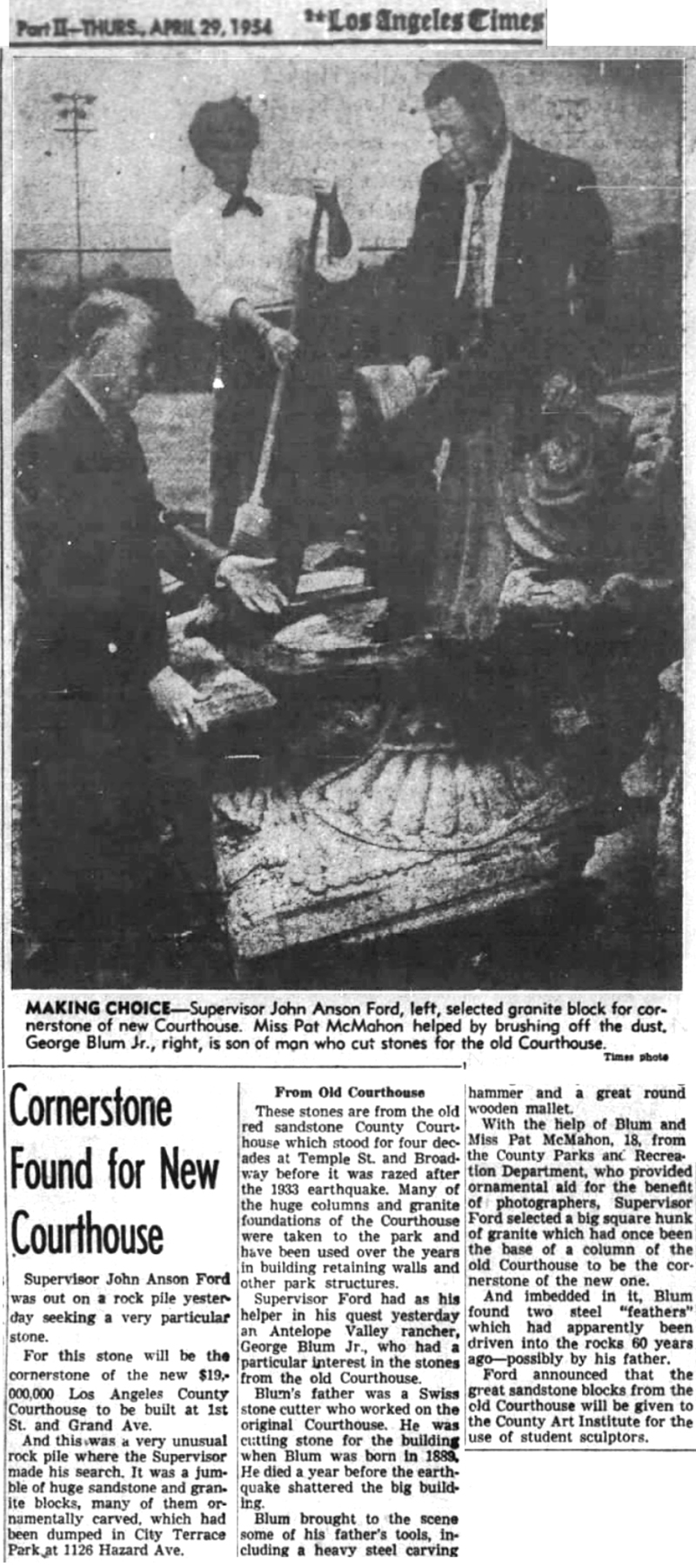Pieces of 1891 L.A. County Courthouse
Built In Part by George Blum of Acton
|
Swiss stonecutter-turned-Acton rancher George Blum Sr. put his master masonry skills to work on L.A. County's central "Red Sandstone Courthouse," under construction from 1888-1891 at the corner of New High (later called Spring) and Temple streets in Los Angeles. Around the time of its completion, Blum homesteaded land in Aliso Canyon, although he maintained residence in Los Angeles for a few years while he got his ranch up and running. Pieces of the Romanesque revival-style courthouse — which was destroyed in the 1933 Long Beach earthquake and demolished in 1936 — still exist in the year 2020. At least two smaller pieces, less than 12 inches square, reside on the Blum Ranch (first two photos above). Blum did not live to see the destruction of "his" courthouse; the remnants may have been retrieved as souvenirs by his eldest son, George John Blum (father of Elizabeth Blum Billet), in 1954, when George Jr. participated in the selection of the cornerstone for the replacement (current) county courthouse that would be built along First Street between Hill Street and Grand Avenue. When the 1891 courthouse was rubble, larger sections of the structure were salvaged and reused as construction materials and decorative architectural features at nearby Los Angeles County parks including City Terrace Park in East Los Angeles and Ladera Park in South Los Angeles, where they can be seen today (remaining photos above). Note that the selection of the cornerstone in 1954 took place at City Terrace Park (see news article below).
In roughly chronological order, the postcards above show the progression of development on Poundcake Hill (Spring and Temple streets). The 1891 courthouse, actually the sixth building used as L.A. County's central courthouse, was erected on the site of the original Los Angeles High School (1873-1886). The adjacent Hall of Records was completed in 1906. It doubled as the courthouse after the earthquake, from 1934 until 1959 when the current courthouse opened. The Hall of Records building was demolished in 1973. Note: The second postcard above, printed and published in Germany, was colorized by someone who didn't know what color the courthouse was supposed to be. The last postcard shows the current county courthouse shortly after it opened at 111 N. Hill Street. The Red Sandstone Courthouse was built in Richardsonian Romanesque style, a type of Romanesque revival style named for architect Henry Hobson Richardson (1838-1886) that incorporates 11th- and 12-century Mediterranean European elements. The style was popular on the East Coast of the United States in the latter part of the 19th Century and was brought West. From Water and Power Associates (waterandpower.org):
Designed by architects Curlett, Eisen and Cuthbertson, the rusticated stone building has wall dormers, column pilasters, cupolas topped with finials, and a large square clock tower with turrets and a central, multi-sided cupola with cast iron cresting and a flagpole. Wide stone staircases connected by walls surround the building. [...] The County Courthouse building utilized an open-air elevator shaft that was added to the building before the turn of the last century [before 1900]. The external elevator shaft can be seen between the left and center sections of the building, especially in the miscolored image. George Blum's masonry tools can be seen here.
Download original images of courthouse relics here.
Download original images of postcards here.
Photos of relics at Blum Ranch by Leon Worden, November 2, 2019. Photos of relics at City Terrace and Ladera parks courtesy of Ansley Davies,
Associate Curator, County of Los Angeles Department of Parks and Recreation.
|

